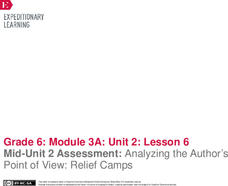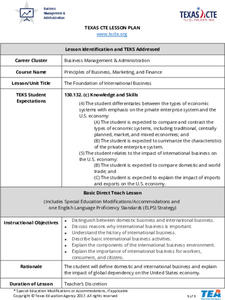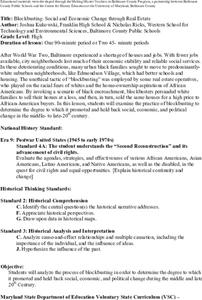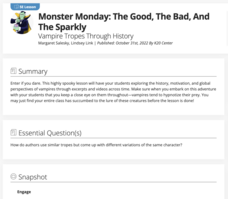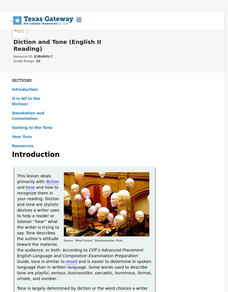National Woman's History Museum
Create your own Women’s History Museum
Celebrate Women's History with a museum display. Divide the class into seven groups and assign each a different historical topic/time period. Each group member researches a different woman of that time period and creates an exhibit that...
Museum of Science
Skyscraper Engineering
The sky's the limit when learning about engineering. Future engineers conduct an activity to learn about forces associated with skyscrapers. They design and build a model of a skyscraper from basic household materials, then test their...
Museum of Science
Paddle Boat
Harness the power of rubber bands of all things. A hands-on activity has scholars design and build paddle boats. They learn how the elastic potential energy of rubber bands can be converted to the kinetic energy associated with motion.
BrainPOP
Famous Historical Figures Lesson Plan: Who Am I?
History detectives select a famous person to research, fill a bag with items associated with their subject, then ask class members to guess the historical figure represented by the artifacts.
EngageNY
Mid-Unit 2 Assessment: Analyzing the Author’s Point of View: Relief Camps
We're halfway there ... what a relief! Scholars read an excerpt from a primary source about the relief camps associated with the1906 San Francisco earthquake. Next, they complete a mid-unit assessment, answering short-answer and...
DiscoverE
Everyday Engineering: Tennis, Anyone?
Take a swing at a fun activity. Pupils first watch a video that introduces the concept of elasticity in association with tennis rackets. They then design their own rackets and build them out of available materials.
US House of Representatives
Objects in Time
Artifacts can be used to study people and events of the past. That's the takeaway from the fifth lesson plan in a unit study of African Americans who served in Congress. Groups select an artifact associated with a Black Congress Member...
Education World
Black History 103
Who was awarded the Nobel Peace Prize for his role in the 1949 Arab-Israeli peace accord? Who wrote many famous rock-and-roll songs? Who helped start the National Association for the Advancement of Colored People (NAACP)? A matching...
Health Smart Virginia
Face of Mental Illness
To develop an understanding of the stigma surrounding mental health problems and the impact stigma and discrimination have on those who would seek help, groups investigate the symptoms of and risk factors associated with eight different...
Texas Education Agency (TEA)
Foundation of International Business
Scholars work in teams to research the geography, economic conditions, and cultural factors associated with conducting business in another country. They create a PowerPoint to show what they've learned, and then design a brochure with...
California Department of Education
Learn to Reach Out
High school seniors use the CareerOneStop website to research professional associations related to careers that interest them. They then develop interview questions and arrange an informational interview with someone in the field.
Center for History Education
Blockbusting: Social and Economic Change through Real Estate
"Redlining," "Blockbusting," and "White Flight" may not be terms familiar to young historians. Here's a lesson that introduces middle schoolers to these terms and the actions associated with them. Class members examine a series of...
Center for History Education
Cold War Case Files: The Rosenberg Trial - Was Justice Fairly Served?
The Rosenbergs—executed for their role in a Soviet-era spy ring—continue the captivate the American imagination. Using a history lab format, young historians examine the trove of documents associated with the case, including photographs...
National Endowment for the Humanities
Symbolism in Lord of the Flies
Readers of Lord of the Flies examine the four main symbols William Golding develops in his novel: the island, the conch, the Lord of the Flies effigy, and fire. Partners select one of the major symbols and create an image by adding words...
Nebraska Department of Education
Stress and Coping
Life can be stressful. Class members fill out T-charts identifying stressors associated with school, parents, friends, and life then list coping strategies that can help with each category.
K20 LEARN
Power to the People
Black berets, black leather jackets, raised black fists, chants of "Power to the People!" These are the images that many associate with the Black Panther Party. Often forgotten are the programs the party created during the Civil Rights...
Facing History and Ourselves
Mood Meter
Returning to in-class learning has proved to be a challenge for both teachers and learners. This series of 15 lessons provides instructors with ideas about establishing or re-establish classroom protocols and opening or closing routines...
Learning for Justice
Looking Closely at Ourselves
A thoughtful discussion about self-reflecting leads to a conversation about skin color and making a list of words associated with "beauty." Budding artists use a mirror to examine their features and create a self-portrait. Peers critique...
Anti-Defamation League
What Is Weight Bias?
After setting rules and expectations to create a safe place to share thoughts and feelings, scholars define the terms; stereotype, basis, and discrimination. Using a web brainstorm, learners list words associated with overweight and...
K20 LEARN
Texture Poetry: The Great Gatsby and the Sense of Touch
To prepare for crafting a descriptive poem about a character in F. Scot Fitzgerald's The Great Gatsby, groups describe the texture of objects hidden in small bags. Individuals then select a character from the novel and an object...
Academy of American Poets
Teach This Poem: “One day is there of the series” by Emily Dickinson
A lesson plan begins with learners saying three words they associate with Thanksgiving dinner. They examine a picture of a menu from a Thanksgiving meal and discuss what they believe the artist wants them to feel, pointing out details....
K20 LEARN
Making Sense of MLA: Citing Sources and MLA Formatting
The Modern Language Association (MLA) Style Sheet is about giving credit where credit is due. And while there are different style sheets, the one most often used in Language Arts is the MLA. In this lesson, high school scholars learn how...
K20 LEARN
Monster Monday - The Good, the Bad, and the Sparkly: Vampire Tropes through History
Fangs, capes, pale skin, and beady eyes! High schoolers investigate the tropes associated with vampires by examining excerpts from stories and films. They then create a timeline that reveals how the depictions of vampires have evolved...
Texas Education Agency (TEA)
Diction and Tone (English II Reading)
Words carry baggage. In addition to their literal, denotative meaning, words also carry the weight of the associations and connotations attached to the word—the connotations of words writers use to create the tone of a piece. An...
Other popular searches
- Associations and Organizations
- American Heart Association
- Picture/word Association
- Ladies Association
- Word Association Activities
- Word Associations
- Modern Language Association
- Word Associations/comparisons
- American Medical Association
- Letter Association
- Vocabulary Word Associations
- Picture Association






